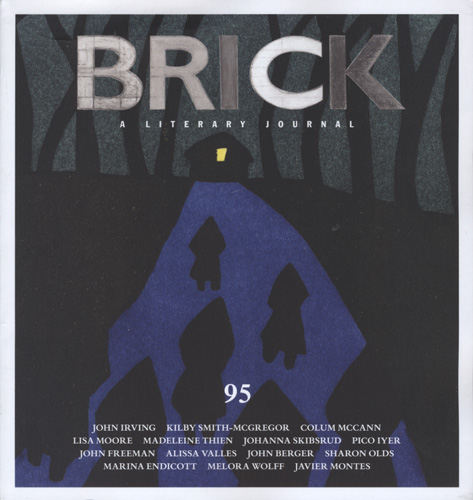Brick – Summer 2015
Brick is a biannual magazine based in Toronto, Canada, with many of the contributors living in Toronto or elsewhere in Canada. Undeniably, then, Brick has a Canadian slant. Brick is a biannual magazine based in Toronto, Canada, with many of the contributors living in Toronto or elsewhere in Canada. Undeniably, then, Brick has a Canadian slant.
Founded in 1977 as a book review publication, Brick is still mainly about books and reading—not about current events, personalities, and new writing. The current issue has a section called “On Childhood Books,” with short pieces by seventeen writers who recall books they read while young. Lisa Moore and Frank Macdonald separately recall Black Beauty, John Goldbach recalls Crime and Punishment, Melora Wolff recalls Peter Pan, and Pico Iyer recalls The Adventures of Tintin. As this sample shows, the list is eclectic. The writers express fond memories, of course, and a few terrors, an interesting look into the commonality and differences among young readers and grown writers.
Allied to the theme of childhood books, this issue has pages of color illustrations from the Osborne Collection of Early Children’s Books and the Contes des fées in the Toronto Public Library. One of these also appears on the cover of the magazine, a spooky scene in a forest at night.
A five page excerpt from Sidewalk Flowers by JonArno Lawson and illustrator Sydney Smith constitute a charming children’s story in the form of a wordless cartoon strip. And John Berger’s essay “One or Two Pages about Vigilance” shows the author floating on his back in a swimming pool, with drawings of leaves and clouds mentioned in the essay, the smudges of color giving off a children’s book feel.
The issue leads with a short story by Madeleine Thien, who writes about reading Dream of the Red Chamber when she was a girl. “The Wedding Cake” features four exiles from Beirut in Montreal, four men who speak Arabic and French. One of them had a son, Victor, who was accidentally killed just before his wedding. Years after the death, the father takes the wedding cake from the freezer, and the men eat it while talking about their lives. A strong piece to begin with.
Eleanor Wachtel contributes “An Interview with James McBride.” McBride was born in 1957 to a white Jewish woman and a black preacher and musician in New York City, and speaks vividly of his childhood. A journalist and jazz musician, he wrote a popular book about his mother The Color of Water, and his love and appreciation for her is evident in this interview. Wachtel reviews McBride’s life and brings the story up to his new novel, The Good Lord Bird.
Erica Johnson Debeljak walks in the footsteps of a famous author in her essay “The Accidental Hero: Ernest Hemingway and Slovenia.” In 1918, at age 18, Hemingway volunteered as an ambulance driver for the American Red Cross at the warfront in northern Italy. A shell hit him in both legs and killed others in the trench. The incident inspired his novel A Farewell to Arms and later work. Debeljak disentangles fact and fiction, and Hemingway the writer comes off better than Hemingway the callow young man.
There are poems by Sharon Olds, John Freeman and Philip Levine, who died this year. There are thoughtful essays on Susan Sontag and Robert Stone, the American novelist who also died this year. In the essay “A Kind of Hunger” Jeannie Marshall writes about how eating in restaurants has changed from her youth: “The shallow pleasure of food is hurting the deeper pleasures of the table,” namely intellectual talk. Jim Harrison closes the issue with “Real Old Food” in his blunt style, ending the nonfiction piece with: “Good food is so much more important than the mediocre writing that pervades the earth.”
Like the item made of clay, Brick is solid and dependable. Unlike masonry, it offers a range of textures and flavors, opinions and tastes.
[www.brickmag.com]





